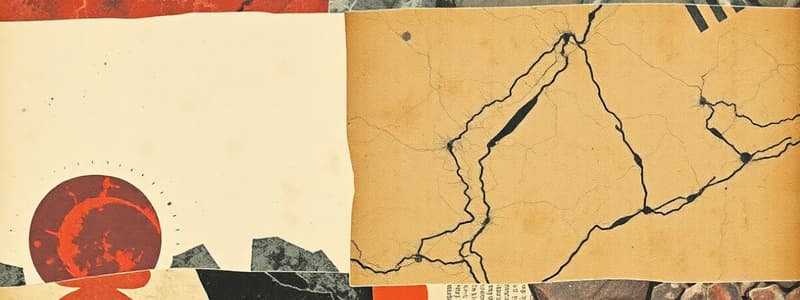Podcast
Questions and Answers
Describe the process of how sedimentary rocks can be transformed into metamorphic rocks.
Describe the process of how sedimentary rocks can be transformed into metamorphic rocks.
Sedimentary rocks are subjected to intense heat and pressure, often deep within the Earth's crust. This transformation changes the rock's texture, mineral composition, and overall structure, leading to the formation of metamorphic rock.
Explain how igneous rocks are formed and give an example of a type of igneous rock.
Explain how igneous rocks are formed and give an example of a type of igneous rock.
Igneous rocks are formed from the cooling and solidification of molten rock, either magma (underground) or lava (above ground). An example of an igneous rock is granite, which is formed from the slow cooling of magma.
What are the key differences between weathering and erosion?
What are the key differences between weathering and erosion?
Weathering is the breakdown of rocks, soil, and minerals through physical or chemical processes, while erosion is the transportation of those broken-down materials by wind, water, or ice.
How does the rock cycle demonstrate the connection between Earth's internal and external processes?
How does the rock cycle demonstrate the connection between Earth's internal and external processes?
Explain how the concept of the rock cycle supports the idea that Earth is a dynamic system.
Explain how the concept of the rock cycle supports the idea that Earth is a dynamic system.
Flashcards
Rock Type
Rock Type
A classification of rock based on its formation and composition: igneous, sedimentary, or metamorphic.
Igneous Rock
Igneous Rock
Rock formed from cooled and solidified magma or lava.
Sedimentary Rock
Sedimentary Rock
Rock formed from the accumulation and compaction of mineral and organic particles.
Metamorphic Rock
Metamorphic Rock
Signup and view all the flashcards
Rock Cycle
Rock Cycle
Signup and view all the flashcards
Study Notes
Igneous Rocks
- Formed from the cooling and solidification of magma or lava.
- Classified based on mineral composition and texture.
- Intrusive igneous rocks (formed beneath the surface) cool slowly, resulting in coarse-grained textures. Examples include granite and gabbro.
- Extrusive igneous rocks (formed on the surface) cool rapidly, resulting in fine-grained textures. Examples include basalt and rhyolite.
- Different compositions reflect the different chemical makeup of the source magma.
Sedimentary Rocks
- Formed from the accumulation and cementation of sediments.
- Classified based on origin.
- Detrital sedimentary rocks are formed from eroded fragments of pre-existing rocks. Sandstone and shale are examples.
- Chemical sedimentary rocks are formed from the precipitation of minerals from solution. Limestone and rock salt are examples.
- Organic sedimentary rocks are formed from the accumulation of organic matter. Coal is an example.
- Often layered, displaying strata or bedding planes.
Metamorphic Rocks
- Formed from the transformation of existing rocks (igneous, sedimentary, or other metamorphic rocks) due to heat and pressure.
- Classified based on texture and mineral composition.
- Regional metamorphism results from large-scale heat and pressure, often associated with mountain building. Slate and gneiss are examples.
- Contact metamorphism occurs when pre-existing rocks are exposed to heat from magma. Marble and quartzite are examples.
- Metamorphic rocks often exhibit foliation, a layered or banded texture. This texture is caused by the alignment of minerals under stress.
The Rock Cycle
- A continuous process that describes the transitions between the three main rock types (igneous, sedimentary, and metamorphic).
- The rock cycle is driven by various geological processes, including weathering, erosion, deposition, heat, and pressure.
- Magma cools and solidifies to form igneous rocks.
- Igneous rocks can be weathered and eroded into sediments.
- Sediments are compacted and cemented to form sedimentary rocks.
- Sedimentary and igneous rocks can be subjected to heat and pressure, converting them into metamorphic rocks.
- Metamorphic rocks can be melted to form magma, starting the cycle anew.
- These processes are interconnected and can occur simultaneously in different locations of the earth's crust.
- The rock cycle is a dynamic system; rocks are continually being formed, transformed, and recycled.
Processes in the Rock Cycle
- Melting: The transformation of solid rock into liquid magma, driven by high temperatures.
- Cooling and crystallization: The process where magma or lava cools and solidifies to form igneous rocks. Different cooling rates result in different textures.
- Weathering and erosion: The breakdown of rocks into smaller fragments (sediments). Agents include wind, water, ice, and chemical reactions.
- Transportation: The movement of sediments from the site of weathering to a new location. Water, wind, ice can all move sediments.
- Deposition: The settling of transported sediments in a new location.
- Compaction and cementation: The processes that solidify sediments into sedimentary rocks. Pressure and mineral deposits bind sediment grains together.
- Metamorphism: The alteration of rocks by heat and pressure, resulting in the formation of new minerals and textures.
Factors Affecting Rock Formation
- Temperature: Affects mineral stability and the type of rocks that form. Melting points are important when considering igneous rock formation.
- Pressure: Influences mineral stability and the density of rocks. Different pressures are prevalent during metamorphism or deep within the earth.
- Composition of parent material: The initial chemical makeup of a rock influences the resulting rock type. This is a key control in sedimentary rock formation.
- Time: Geological processes occur over long timescales, influencing the formation and transformation of rocks. This means that certain processes may take millions of years.
Studying That Suits You
Use AI to generate personalized quizzes and flashcards to suit your learning preferences.




